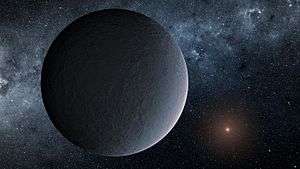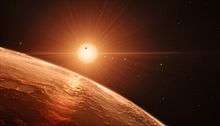OGLE-2016-BLG-1195Lb
| Exoplanet | List of exoplanets | |
|---|---|---|
 | ||
| Parent star | ||
| Star | OGLE-2016-BLG-1195L | |
| Constellation | Scorpius | |
| Right ascension | (α) | 17h 55m 24.0s[3] |
| Declination | (δ) | −30° 12′ 26″[3] |
| Distance | 13,000[4] ly (3,910.0[3] pc) | |
| Spectral type | unknown (possibly "a brown dwarf or an ultracool dwarf"[6]) | |
| Physical characteristics | ||
| Mass | (m) | 1.43[1][4] M⊕ |
| Discovery information | ||
| Discovery date | 2017[3][4] | |
| Discoverer(s) | ||
| Discovery method | Gravitational microlensing[4] | |
| Discovery site | Korea Astronomy and Space Science Institute and Spitzer Space Telescope[4] | |
| Discovery status | Published[1][2][4] | |
| Database references | ||
| Extrasolar Planets Encyclopaedia | data | |
| SIMBAD | data | |
| Exoplanet Archive | data | |
| Open Exoplanet Catalogue | data | |
OGLE-2016-BLG-1195Lb is an extrasolar planet located nearly 13,000 light-years from Earth, orbiting the star OGLE-2016-BLG-1195L, which is only 7.8 percent the size of the Sun.[4][5] This planet was detected in 2017[3] using gravitational microlensing techniques managed by the Korea Astronomy and Space Science Institute and the Spitzer Space Telescope. It has a mass similar to Earth and is located about the same distance from its host star as the Earth is from the Sun. However, the host star is so small that it may not be a star at all.[4] It may be "a brown dwarf or an ultracool dwarf" instead, so the planet is likely far too cold to be habitable.[7][6] Based on its currently observed properties, the 'iceball' planet may be described as a very cold Earth-like exoplanet.[4]
In popular culture
The planet has been referred to as Hoth due to its resemblance to the planet with the same name from the Star Wars franchise.[6] A similar exoplanet, OGLE-2005-BLG-390Lb, has also been compared to Hoth, by NASA in this instance.[8]
See also
References
- 1 2 3 Shvartzvald, Y; et al. (1 May 2017). "An Earth-mass Planet in a 1 au Orbit around an Ultracool Dwarf" (PDF). The Astrophysical Journal Letters. 840 (L3): 1–7. doi:10.3847/2041-8213. Retrieved 27 April 2017.
- 1 2 Bond, I. A.; et al. (25 March 2017). "The Lowest Mass Ratio Planetary Microlens: OGLE 2016-BLG-1195Lb". Monthly Notices of the Royal Astronomical Society. 469: 2434–2440. arXiv:1703.08639. Bibcode:2017MNRAS.469.2434B. doi:10.1093/mnras/stx1049.
- 1 2 3 4 5 6 Staff (2017). "Planet OGLE-BLG-1195L b". Extrasolar Planets Encyclopaedia. Archived from the original on 31 March 2017. Retrieved 27 April 2017.
- 1 2 3 4 5 6 7 8 9 10 Staff (26 April 2017). "PIA21430: Iceball Planet Artist's Concept". NASA. Retrieved 27 April 2017.
- 1 2 Landau, Elizabeth (26 April 2017). "'Iceball' Planet Discovered Through Microlensing". NASA. Retrieved 27 April 2017.
- 1 2 3 Strickland, Ashley (26 April 2017). "Icy Earth-mass exoplanet is 'colder than Hoth'". CNN. Retrieved 27 April 2017.
- ↑ https://www.sciencedaily.com/releases/2017/04/170426122437.htm
- ↑ Brennan, Pat (15 December 2015). "8 planets that make you think Star Wars is real". NASA. Retrieved 29 April 2017.
Coordinates: ![]()

